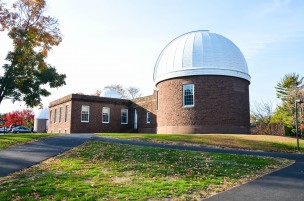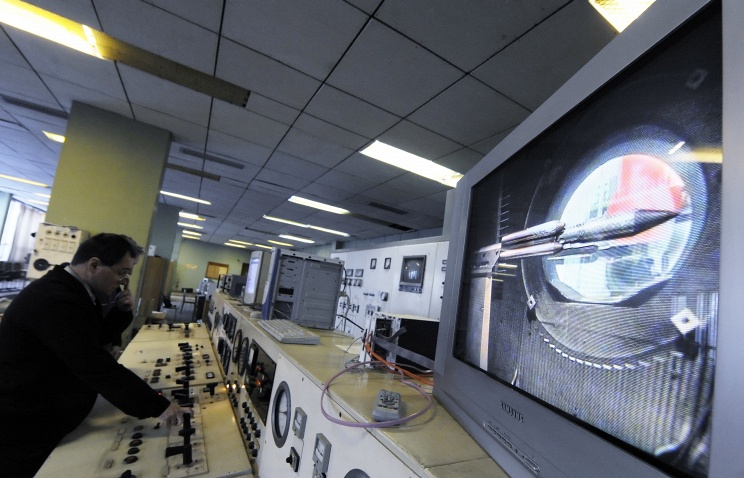On a Friday night in October, Jesse Shanahan, a graduate student in
the Astronomy Department, stood behind an inflatable planetarium. The
silver, blown-up stellar theatre, they explained (Shanahan uses
gender-neutral pronouns), was part of Kids’ Night, a public outreach
program aimed at children. Later, kids would go inside to view
projections of the stars and constellations in the night sky.

Shanahan founded Kids’ Night earlier this year. When we spoke,
though, they expressed a major concern: the location. Shanahan advocates
for disability rights within the American Astronomical Society (AAS),
the largest astronomical organization within the United States. As with
other events the Astronomy Department hosts, Kids’ Night is housed in
the Van Vleck Observatory, a building that has no
wheelchair-accessible entrances.
“I worked primarily with kids with disabilities and cognitive
impairments and stuff [with an outside organization], especially, and
they would not be able to come to an event that I put on here,” Shanahan
said. “That really bothers me.”
Currently, the Astronomy Department—working with Physical Plant and
the Office of Student Affairs, of which Disability Resources is a
part—is in the process of addressing Shanahan’s concerns. Physical Plant
is currently working with an outside architect to draw up plans to
build a ramp in the architectural style of the 99-year-old building,
making the observatory wheelchair-accessible on the first floor.
These plans would still not make accessible the dome for the 20-inch
telescope, however. In order to address this concern, a monitor will be
installed inside the library of the observatory, connected to a camera
that will be attached to the 20-inch telescope.
According to Roy Kilgard, Support Astronomer and Research Associate
Professor of Astronomy, initial plans to address accessibility issues at
Van Vleck Observatory included the possibility of making the 20-inch
telescope dome wheelchair accessible, but were abandoned due to
logistical concerns.
“There’s a lot of challenges involved in [making the dome
wheelchair-accessible]; it’s unclear that it ever would’ve worked for
any sum of money and it would’ve been a massive renovation to the
building,” Kilgard said. “So that was ruled out.”
Kilgard said he came up with the idea of the camera as a more
affordable and feasible solution to the problem of making the dome
accessible. The camera and monitor, he later wrote in an email to The
Argus, will be installed by the beginning of spring semester.
Efforts to make the Van Vleck Observatory more accessible,
administrative officials said, are part of a larger plan for the
University to address concerns regarding accessibility on campus and
meeting the requirements of the Americans with Disabilities Act (ADA),
a 1990 law that requires that people with disabilities are offered
reasonable accommodations from employers. As with the rest of the
University, they said, the age of the observatory and the hilly terrain
surrounding it make these concerns especially hard to address.
“There’s a constant conversation on campus around accessibility,”
Laura Patey, Associate Dean of Student Academic Resources, said. “I
mean, we recognize that [with] topography and the age of some of our
buildings, accessibility is a challenge on this campus. And we’re always
wanting to improve that.”
According to a document provided by Roseann Sillasen, Associate
Director and Project Manager of Facilities, the University has spent
through Physical Plant $2.23 million since 2003 on campus-wide
accessibility projects. Those initiatives range from making pathways
more accessible to building restrooms designed for wheelchair users to
putting ADA-compliant phones, which are required to be hearing-aid compatible, into elevators.
The University has limited funds set aside for ADA-related
projects; The Facilities Planning Committee—an executive committee of
the University—sets priorities about which parts of campus are first
renovated for accessibility concerns, Sillasen said. According to
University President Michael Roth, a large factor in setting these
priorities lies in how much activity different buildings experience.
“Those buildings that have either the most public or student activity
we want to make sure are the most accessible first, and then we hope
that every building meets ADA requirements and goes beyond them when we can,” Roth said.
Until this summer, the Van Vleck Observatory had not received money
from the University to address accessibility concerns. The reason for
this, Sillasen suggested, is because Physical Plant makes assessments
about which ADA-related projects it does based on student and faculty feedback—and, until somewhat recently, it had received none.
“No student has asked me about Van Vleck,” Sillasen said. “So I have
had a request from the chair of the department. And at that time, I had
provided some very broad scope schematics looking at topography and now
we have an architect who’s providing some schematic designs from us.”
Sillasen said that the University uses feedback from people in the
Wesleyan community, in large part, as a way of identifying which parts
of campus have issues with accessibility.
“I’m out there on campus a lot, but I don’t have the opportunity to be everywhere on campus,” Sillasen said.
In order to address what some of these concerns are, Disability Resources added an ADA/Campus Access Barriers Report Form, through which students, faculty, staff, and visitors can report accessibility concerns, Patey said.
“This would provide an opportunity for anyone in the community to
help us identify barriers that might exist for an individual,”
Patey said.
But at places like the Van Vleck Observatory, where faculty and
administrative officials have long known about lack of access for
wheelchair users and other people with disabilities, waiting for
students or faculty to issue complaints concerns Shanahan.
“I think a lot of people have good intentions to change things,”
Shanahan said. “But I hate that we have to wait for somebody to be in
need before we make changes.”
Even with an understanding of areas on campus where accessibility
issues need to be addressed, renovations to make buildings accessible
take time to implement. In an email sent to The Argus, Patey pointed to
several other academic buildings on campus that are not accessible,
including the Anthropology building on 287 High Street and buildings in
the Center for the Arts.
Physical Plant, Kilgard said, has been looking at adding a ramp to the Van Vleck Observatory for a number of years.
“They’ve just been putting it into the long-term planning for
construction that happens to the University,” Kilgard said. “Those
things take a very long time to filter through. It’s not as fast as you
would like it to be.”
And the process is far from over. This June, the Astronomy Department
will be hosting a centennial celebration in honor of the hundredth
anniversary of the Van Vleck Observatory. Although faculty within the
Astronomy Department had hoped to see a ramp installed by then—along
with other features, like the building of an accessible restroom and
doorways and entryways designed for wheelchairs—such changes are
unlikely to occur by then.
“It’s going to take years, is my guess,” Moran said.
On the day of the centennial, Kilgard said, Physical Plant will
install a temporary ramp to the Van Vleck Observatory. In part, this is
intended to allow visitors access to the building. It will also be
installed, Shanahan said, because the J. Monroe Van Vleck Professor of
Astronomy, Emeritus, Arthur Upgren, plans to visit the Observatory and
is a wheelchair user.
“He can’t get into his own department, where he worked here for
decades,” Shanahan said. “And so, we have our centennial celebration
next semester and he can’t get into the building.”
Because of the ramp, Upgren should be able to view the inside of the
building. Still, faculty in the Astronomy Department wait to see a more
permanent fixture installed—one that would allow Shanahan’s students to
visit Kids’ Night on any Friday night they choose.
Source: Wesleyan Anargus, 22nd Oct 2015
























